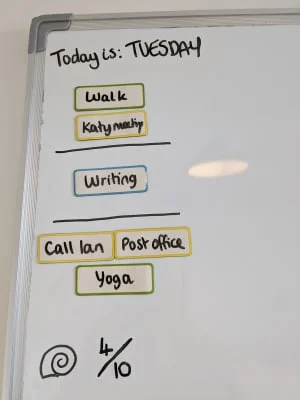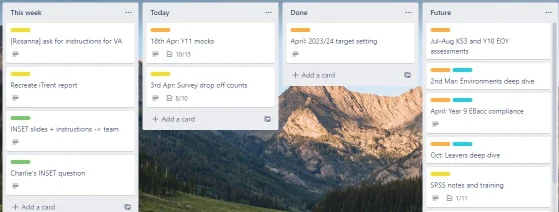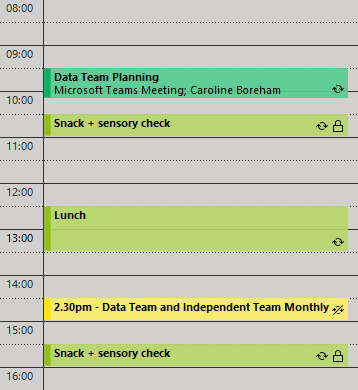Using visual aids
How visual aids make work “work” for me
Visual aids free up valuable computing space in my brain. They keep the mental work on the outside. They stop me from running things through over and over. And over.
Before my diagnosis, I felt like certain things weren’t “for me”… Fidget toys, weighted blankets, visual timetables, all sorts of things.
Now, things look different. They feel different. And I am somewhat in control of my anxiety levels for the first time in my life. I’m going to share exactly how I use visual aids, and how this helps me at work. These will be split into two categories:
1. Visual aids that help manage my overall energy levels: these help me get to a lower “baseline” level of anxiety, so I am more able to cope with work obligations in general, which makes everything more sustainable
2. Visual aids that help me complete work: specifically targeted at helping me feel in control of my workload and clear about what tasks I need to do
1. Visual aids that help manage my overall energy levels

Day of the week. I write the day of the week on a whiteboard each morning. It helps orientate me. When I don’t have this, I tend to spend a lot of time working out what day it is and what is coming up.
Visual schedule so I know when I need to add in some rest. Also on a whiteboard, I write out my main activities for that day. These are on colour-coded magnetic whiteboard strips. Anything social is on a strip with a yellow border. When I see a very “yellow” day ahead of me, I think about whether I have the energy to do it all. If not, I might delay or cancel something. And regardless I will schedule some extra rest during the day or soon after.
Energy level out of ten. I try to write an “energy level out of ten” on my whiteboard each morning. If I’m running low on energy, as above, I can make adjustments and in general be a bit kinder to myself! It’s a good reminder for me to pay attention to how I am feeling, and helps me notice if I’m feeling tired or unwell.
Reminders to eat. I have “snack and sensory check” reminders in my work calendar at 10.30 and 15.30 each day. When I get very focused on a task, I can easily forget to eat, or ignore that I’ve become far too warm. That used to mean getting very hungry or feeling unwell without warning. Now, these reminders act as a safety net and stop me getting to that point.
Visual morning routine. I sometimes find mornings quite disorientating, with a feeling of not knowing “what I am supposed to do”. I can miss different steps like brushing my teeth or going out for a walk if I don’t spend lots of time running over the sequencing in my mind. Instead, I now have this written down somewhere so I can see it first thing. There are two versions, one for days when I go to the gym or go for a run, and one for “chill” days. This prevents me from getting stuck and confused.

2. Visual aids that help me complete work

For context, I work full time as a Data Analyst in the education sector. I am fully remote, and have accommodations in place with my line manager (she is also autistic!) so that I can take extra breaks if I need to.
Fidget toys on my desk. If they aren’t on my desk i.e. are somewhere out of sight, I sometimes forget they exist for weeks on end! So, I keep them in sight. I fiddle with things while in meetings or while I’m thinking. They help keep me calm and focused. My go-to toys are stickle bricks, stretchy things, and a foam stress ball (the squishy ones feel too sticky to me sometimes).
Colour coding my work tasks. I use a Trello board to manage my work tasks, but this would work with any tool. For me, orange = high priority, yellow = medium priority, green = low priority, blue = “blocked” i.e. I am waiting on someone else to do something before I can continue. The colours help me easily see which thing to work on first. I tend to have a long list of all my upcoming tasks, then drag some of those on a Friday afternoon into a “This week” column for the following week. Each day, I pull some of those across into a “Today” column. The orange and yellow tasks come first. Ideally, by Thursday or Friday, I’m only left with some nice, low priority green tasks. For me it helps to break this down day-by-day, else I feel too overwhelmed looking at a long list and having to compute everything every time I look.


Calendar colour coding. I also colour code calendar invites, so I can quickly see if I’ve got a challenging day ahead, and what sort of “mode” I need to be in. For example, here yellow = “external meeting”, which usually means I will need to do more preparation and it will take more energy from me. Green = meetings within my own team, which won’t require as much energy. If I look at my calendar and see a very “yellow” day or week, just like with my visual schedule above, it means I need to look after my energy levels a bit more proactively than usual. I might take more breaks, cancel plans, or reduce the number of other tasks on my list for the week.
Archiving emails. I will archive emails whenever I’m “done” with them. If something still needs my attention, it stays in the inbox. If it doesn’t, it gets archived. That way I don’t have to mentally filter through what I’m seeing to decide if it still matters or not. Sometimes, I will turn a non-urgent email into a task on my Trello board and archive the email so that it’s not cluttering things up. I know that if it is on my task list, I will come back to it eventually.
April 2023

